I've been on a Ingmar Bergman jag the last few days.
What I like about Bergman is that he doesn't tell us how to react or feel but leaves us to make our own judgments.
The DVDs that I purchased have interviews with Bergman on them, and from what I can gather, Bergman went through a lot of struggles personally and artistically. There are interviews with Liv Ullmann, also. Ullmann starred in several Bergman films and also was romantically involved with him. She had a child by him.
One of the things she says in her interview about The Hour of the Wolf is that she should have listened to her character, Alma. If she had, she might not have spent so much time trying to work it out with Bergman, trying to live with a man who had so many issues he was trying to work out.
I thought his comment was telling.
Another thing Ullmann talks about is that when one lives with a person who is disintegrating, one runs the danger of being prone to the same forces as the disintegrating person. In other words, if you live with a disturbed person, you can take on qualities of being a disturbed person yourself. The Hour of the Wolf, like so much great drama, exaggerates the crisis, and to great effect, I think.
King plays around with the idea a bit more, gives the Torrance child a special ability to see into another reality. So the situations in the two films aren't parallel right down the line, but the caparisons between the two are pretty fascinating.
Another comparison: in both The Shining and The Hour of the Wolf, the wives are enablers. They believe that if they love their husbands enough, help them enough, support them enough, then things will turn out fine in the end. This is a dangerous assumption.
Narcissism in an artist is dangerous because it kills the art he or she is trying to create. I think it's interesting that in both works, the artist either kills or attempts to kill a child. What does the child represent? Perhaps his creative effort? It's hard to say, but intriguing to think about.
*****Subsequent thoughts*****
The Shining is a novel by Stephen King and was also made into a movie (actually, two movie versions of the novel have been made). The Hour of the Wolf is a film by Ingmar Bergman.
Both The Shining and The Hour of the Wolf are about artists. In both cases, the artist falls prey to inner chaos, causing complete personality disintegration. In The Shining, Jack Torrance takes a job as a caretaker at the Overlook Hotel. He wants quiet time in order to devote to writing his novel. He is also attempting to escape personal and social problems stemming from an incident of abusing his son.
In The Hour of the Wolf, Johan Borg goes to a remote island in order to paint. He is also escaping elements of his past, including a love affair which turned out badly. Both artists live in seclusion with their wives and slowly go mad. There are also erotically charged elements to both works. For instance, in The Shining, Jack finds himself seduced by a woman who at first appears to be beautiful and young, but who shifts into a hag resembling a rotting corpse.
In The Hour of the Wolf, Johan finds himself in an embrace with an old woman and, later, confronts his former lover who at first poses as a corpse.
I believe the artist must go through a death embrace in order to create. The ego must dissolve and part of the consciousness of the artist must die. But there is a danger, too, in losing the ego all together. Somehow, a balance must be struck within the artist if he or she is going to survive the creative process in tact.
Ingmar Bergman said in a late-life interview that he felt as though he was always only a few steps from chaos. His fear of losing control is dealt with in several of his films, including The Hour of the Wolf.
All artists, to some degree, recognize the danger of what they do. In order to create, the artist has to draw from the dangerous well of the unconscious. There be dragons.
The passion for creating art can be destructive as well as creative. Both The Shining and The Hour of the Wolf show what happens when the destructive quality of passion is allowed to take over. The artist becomes a prisoner of the imagination, just as Jack Torrance becomes a prisoner of the Overlook and as Johan Borg becomes a prisoner to his humiliations.
Both artists "die" because they cannot reconcile the dark forces of the imagination with Apollo, the light of reason. Indeed, in The Hour of the Wolf, Bergman touches on the idea of darkness and light by integrating elements of Mozart's The Magic Flute into the film. Jack Torrance quite literally freezes to death. Apollo, the Sun god, is no where in evidence. Torrance is slain by the dark forces within.
Both works, too, feature "castles" which are labyrinthine in structure. The Overlook Hotel is a kind of huge, sprawling castle. In The Hour of the Wolf, Johan visits a castle where strange and horrific things happen. In both cases, the castle represents the sprawling and confused mind of the artist.
Both works are instructive to artists and fascinating to me, especially as I began to compare them. I know there are some artists who won't relate to this idea of the dark forces within, but many artists will.
Saturday, October 06, 2007
Subscribe to:
Post Comments (Atom)
Pages
Dreaming
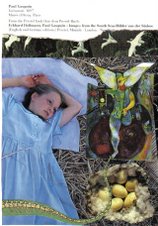
About Me

- Theresa Williams
- Northwest Ohio, United States
- "I was no better than dust, yet you cannot replace me. . . Take the soft dust in your hand--does it stir: does it sing? Has it lips and a heart? Does it open its eyes to the sun? Does it run, does it dream, does it burn with a secret, or tremble In terror of death? Or ache with tremendous decisions?. . ." --Conrad Aiken
Followers
Facebook Badge
Search This Blog
Favorite Lines
My Website
Epistle, by Archibald MacLeish
Visit my Channel at YouTube
Great Artists
www.flickr.com
This is a Flickr badge showing public photos from theresarrt7. Make your own badge here.
Fave Painting: Eden
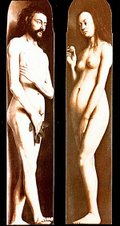
Fave Painting: The Three Ages of Man and Death

by Albrecht Dürer
From the First Chapter
The Secret of Hurricanes : That article in the Waterville Scout said it was Shake- spearean, all that fatalism that guides the Kennedys' lives. The likelihood of untimely death. Recently, another one died in his prime, John-John in an airplane. Not long before that, Bobby's boy. While playing football at high speeds on snow skis. Those Kennedys take some crazy chances. I prefer my own easy ways. Which isn't to say my life hasn't been Shake-spearean. By the time I was sixteen, my life was like the darkened stage at the end of Hamlet or Macbeth. All littered with corpses and treachery.
My Original Artwork: Triptych
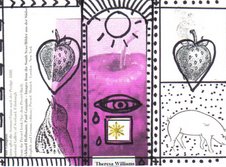
Wishing
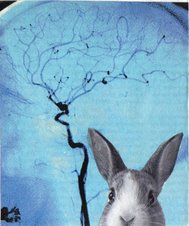
Little Deer
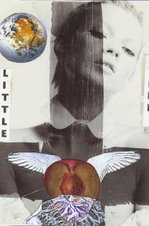
Transformation
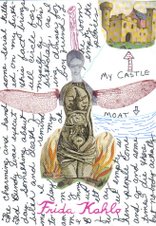
Looking Forward, Looking Back
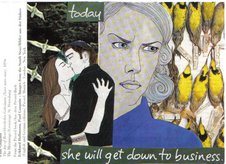
CURRENT MOON
Labels
- adolescence (1)
- Airstream (7)
- Alain de Botton (1)
- all nighters (2)
- Allen (1)
- altars (1)
- Angelus Silesius (2)
- animals (1)
- Annie Dillard (1)
- Antonio Machado (2)
- AOL Redux (1)
- April Fool (1)
- Archibald MacLeish (1)
- arts and crafts (55)
- Auden (1)
- awards (2)
- AWP (2)
- Bach (1)
- Basho (5)
- Beauty and the Beast (1)
- birthdays (1)
- blogs (5)
- boats (2)
- body (2)
- books (7)
- bookstores (1)
- Buddha (1)
- Buddha's Little Instruction Book (2)
- butterfly (4)
- buzzard (2)
- Capote (4)
- Carmel (1)
- Carson McCullers (1)
- cats (15)
- Charles Bukowski (1)
- Charles Simic (2)
- Christina Georgina Rossetti (1)
- church (2)
- confession (1)
- Conrad Aiken (1)
- cooking (5)
- crows (1)
- current events (2)
- D. H. Lawrence (3)
- death (6)
- Delmore Schwartz (4)
- detachment (1)
- dogs (7)
- domestic (3)
- dreams (21)
- Edward Munch (4)
- Edward Thomas (1)
- Eliot (3)
- Eliot's Waste Land (2)
- Emerson (2)
- Emily Dickinson (10)
- ephemera (1)
- Esalen (6)
- essay (3)
- Eugene O'Neill (3)
- Ezra Pound (1)
- F. Scott Fitzgerald (1)
- fairy tales (7)
- Fall (16)
- Famous Quotes (16)
- festivals (2)
- fire (5)
- Floreta (1)
- food (1)
- found notes etc. (1)
- found poem (2)
- fragments (86)
- Frida Kahlo (1)
- frogs-toads (4)
- Georg Trakl (1)
- gifts (1)
- Global Warming (1)
- Gluck (1)
- goats (1)
- Goodwill (1)
- Great lines of poetry (2)
- Haibun (15)
- haibun moleskine journal 2010 (2)
- Haiku (390)
- Hamlet (1)
- Hart Crane (4)
- Hayden Carruth (1)
- Henry Miller (1)
- holiday (12)
- Hyman Sobiloff (1)
- Icarus (1)
- ikkyu (5)
- Imagination (7)
- Ingmar Bergman (1)
- insect (2)
- inspiration (1)
- Issa (5)
- iTunes (1)
- Jack Kerouac (1)
- James Agee (2)
- James Dickey (5)
- James Wright (6)
- John Berryman (3)
- Joseph Campbell Meditation (2)
- journaling (1)
- Jung (1)
- Juniper Tree (1)
- Kafka (1)
- Lao Tzu (1)
- letters (1)
- light (1)
- Lorca (1)
- Lorine Niedecker (2)
- love (3)
- Lucille Clifton (1)
- Marco Polo Quarterly (1)
- Marianne Moore (1)
- Modern Poetry (14)
- moon (6)
- movies (20)
- Muriel Stuart (1)
- muse (3)
- music (8)
- Mystic (1)
- mythology (6)
- nature (3)
- New Yorker (2)
- Nietzsche (1)
- Northfork (2)
- November 12 (1)
- October (6)
- original artwork (21)
- original poem (53)
- Our Dog Buddha (6)
- Our Dog Sweet Pea (7)
- Our Yard (6)
- PAD 2009 (29)
- pad 2010 (30)
- Persephone (1)
- personal story (1)
- philosophy (1)
- Phoku (2)
- photographs (15)
- Picasso (2)
- Pilgrim at Tinker Creek (1)
- Pillow Book (5)
- Pinsky (2)
- plays (1)
- poem (11)
- poet-seeker (9)
- poet-seer (6)
- poetry (55)
- politics (1)
- poppies (2)
- presentations (1)
- Provincetown (51)
- Publications (new and forthcoming) (13)
- rain (4)
- Randall Jarrell (1)
- reading (6)
- recipes (1)
- Reciprocity (1)
- Richard Brautigan (3)
- Richard Wilbur (2)
- Rilke (5)
- river (5)
- river novel (1)
- rivers (12)
- Robert Frost (2)
- Robert Rauschenberg (1)
- Robert Sean Leonard (1)
- Robinson Jeffers (1)
- Rollo May (2)
- Rumi (1)
- Ryokan (1)
- Sexton (1)
- short stories (13)
- skeletons (2)
- sleet (1)
- snake (1)
- Snow (24)
- solitude (1)
- spider (2)
- spring (1)
- Stanley Kunitz (1)
- students (2)
- suffering (4)
- suicide (2)
- summer (20)
- Sylvia Plath (2)
- Talking Writing (1)
- Tao (3)
- teaching (32)
- television (4)
- the artist (2)
- The Bridge (3)
- The Letter Project (4)
- The Shining (1)
- Thelma and Louise (1)
- Theodore Roethke (16)
- Thomas Gospel (1)
- Thomas Hardy (1)
- toys (3)
- Transcendentalism (1)
- Trickster (2)
- Trudell (1)
- Ursula LeGuin (1)
- vacation (10)
- Vermont (6)
- Virginia Woolf (1)
- Vonnegut (2)
- Wallace Stevens (1)
- Walt Whitman (8)
- weather (7)
- website (3)
- what I'm reading (2)
- William Blake (2)
- William Butler Yeats (5)
- wind (3)
- wine (2)
- winter (24)
- wood (3)
- Writing (111)
- Zen (1)





4 comments:
I've never seen the Hour of the Wolf, but am fascinated by the parallels with The Shining. My brother made me overcome my resistance to Stephen King, insisting I read The Shining first. I've been a fan ever since (20 years?)
"I suppose that's what the final sequence tries to express. The notion of love as the only thinkable form of holiness."
Ingmar Bergman re. "The Hour of the Wolf"
Stephen King recalled Kubrick calling him late at night while he was filming The Shining and Kubrick asked him, "Do you believe in God?" King said that he had answered, "Yes," but has had three different versions of what happened next. One time, he said that Kubrick simply hung up on him. On other occasions, he claimed Kubrick said, "I knew it," and then hung up on him. On yet another occasion, King claimed that Kubrick said, before hanging up, "No, I don't think there is a God." In more recent interviews, King has had yet another version of the "God" story, in which Kubrick calls King and asks him if he thinks ghost stories are optimistic because they all suggest there is life after death. King replies, "What about hell?" There is a pause and Kubrick says, "I do not believe in hell."
Wikipedia
Bergman and Kubrick- Monumental directors!
Gretchen
"Hmm, tricky. I think he believed in something, if you understand my meaning. He was a bit of a fatalist actually, but he was also very superstitious. Truly a mixture of nature and nurture. I don't know exactly what he believed, he probably would have said that no-one can really ever know for sure, and that it would be rather arrogant to assume that one could know. I asked him once after The Shining, if he believed in ghosts. He said that it would be nice if there "were" ghosts, as that would imply that there is something after death. In fact, I think he said, "Gee I hope so."...He did not have a religious funeral service. He's not buried in consecrated ground. We always celebrated Christmas and had huge Christmas trees."
Katharina Kubrick Hobbs, when asked if Stanley Kubrick believed in God
Wikipedia
Kubrick's form of spirituality is evident in his film, "2001"
Gretchen
Well, whatever is, is. No amount of believing or unbelieving will make a dent in it. Like you and your visitors, I am also exploring myth and its meaning. Al Gore won the Nobel Peace Prize and I wonder if that is symbolic of a rift in the old mythological thinking (domination over nature, the subjugation of nature) and a move toward a new model, maybe a planetary one. God knows we need it if we are to avoid self-destruction, whether by global warming or aka Cormac McCarthy's vision in The Road. Teagrapple.
Post a Comment